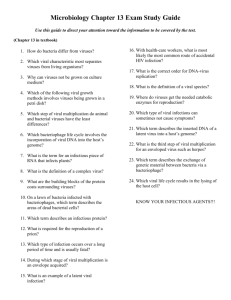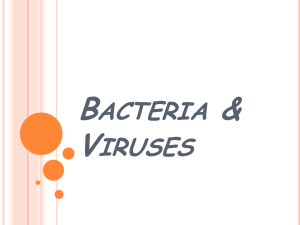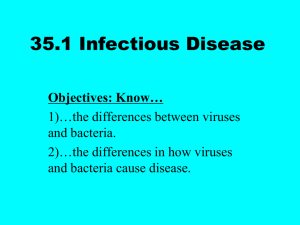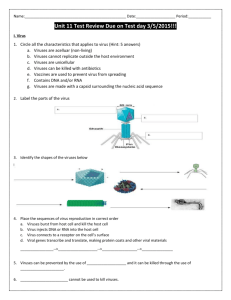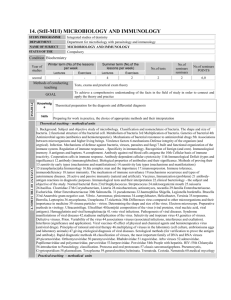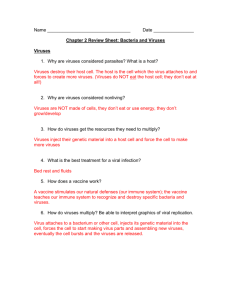HB_Agents_of_Disease_14_BH
advertisement
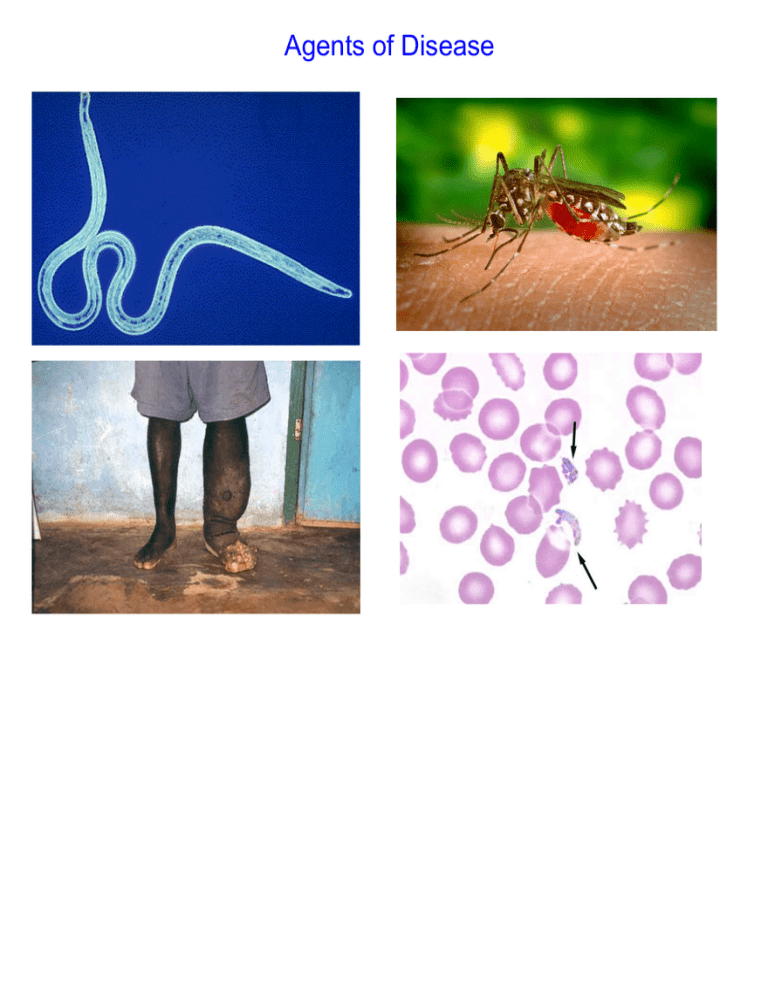
Agents of Disease Bacteria and Viruses and Parasites, Oh My! 1. What is an infectious agent? A pathogen that can cause a disease and is communicable Disease: any deviation from or interruption of the normal structure or function of any body part, organ, or system Communicable: capable of being spread from organism to organism Koch's Postulates 1) The microorganism must be present when the disease is present but absent in healthy organisms 2) It must be possible to isolate the microorganism 3) The isolated microorganism must cause the disease when placed into a healthy organism 4) It must be possible to re-isolate the microorganism from the second diseased host Purpose of the Host 3. What is the pathogen using the host for? Food Shelter Place to grow/replicate Place to eliminate its wastes Three Classes of Disease Agents 6. Order the agents of disease according to size (smallest to largest) Viruses, Bacteria, Parasites Smallest Largest Bacteria Biological characteristics of infectious agent - Single celled, prokaryotic (lack nucleus and organelles) - Have a polysaccharide cell wall outside of cell membrane - 3 shapes Spherical (cocci) Rod (bacilli) Spiral (spirochete) - Can be seen with a light microscope Peptidoglycan Cell Wall Bacterial Shapes Rod-shaped Bacilli Spherical Cocci Spiral-shaped Spirochete Bacteria What the agent does to cause symptoms - Secrete toxic substances that damage tissues - Feed on nutrients intended for host - Form colonies that disrupt normal functions in the host body Bacteria How the infectious agent is transmitted to the host - Limited mobility - Rely on carriers such as animals (including insects), water & food Bacteria Method(s) of treatment - Antibiotics Strep Throat - Group A streptococcal infection - Hemolysin - causes breaks down of red blood cells Cholera - Vibrio cholerae - Infects the small intestine - Causes intense diarrhea and vomiting - Worldwide, it affects 3–5 million people and causes 100,000–130,000 deaths a year as of 2010 Syphilis - Sexually transmitted infection - Spirochete bacterium Treponema pallidum - Syphilis is believed to have infected 12 million people worldwide in 1999, with greater than 90% of cases in the developing world Typhoid Fever - Salmonella enterica - Headache, cough, bloody nose, abdominal pain, leukopenia, a decrease in the number of circulating white blood cells - Intestinal hemorrhage or perforation, encephalitis, neuropsychiatric symptoms (delirium and muttering) Mary Mallon ("Typhoid Mary") in a hospital bed (foreground). She was forcibly quarantined as a carrier of typhoid fever in 1907 for three years and then again from 1915 until her death in 1938. Tetanus - Tetanospasmin, a neurotoxin produced by the Gram-positive, rod-shaped, obligate anaerobic bacterium Clostridium tetani. Tetanus often begins with mild spasms in the jaw muscles (lockjaw). The spasms can also affect the chest, neck, back, and abdominal muscles. Back muscle spasms often cause arching, called opisthotonos. These episodes can cause fractures and muscle tears. Parasites Biological characteristics of infectious agent - Eukaryotic pathogens - Live in symbiosis with host - Types Protozoa (protists) Worms Arthropods (insects) Fungi - Can be seen with a light microscope or the naked eye Parasites What the agent does to cause symptoms - Mechanical injury (ex. boring holes through tissue) - Eating or digesting tissue of host - Toxin release poisons host - Robbing nutrients from host Parasites How the infectious agent is transmitted to the host - Contaminated food or water - Direct contact - Feces or saliva of insects or other animals Parasites Method(s) of treatment - Depends on parasite - Medication - Prevention by good hygiene, water treatment, sanitary conditions - Insect control Malaria - Protist (Phylum Apicomplexa), Genus Plasmodium - Fever, shivering, joint pain, vomiting, hemolytic anemia, jaundice, retinal damage, convulsions - Enlarged spleen or liver, severe headache, hemoglobinuria with renal failure may occur(hemoglobin from lysed red blood cells leaks into the urine) - Coma and death Tapeworm - Phylum Platyhelminthes, Class Cestoda - Scolex hooks into wall of digestive tract - Can have no symptoms - Abdominal discomfort, diarrhea, loss of appetite - Blockage of intestine - Rarely, T. solium larvae can migrate to the brain causing severe headaches, seizures and other neurological problems Schistosomiasis - Phylum Platyhelminthes, Genus Schistosoma - Fluke with intermediate snail host - Transmitted by playing/drinking infected water - Damage to internal organs, delay in growth/cognitive development - Risk of bladder cancer Viruses Biological characteristics of infectious agent - Not a cell, not alive - Nucleic acid in a protein coat (capsid) - Genome can be DNA or RNA (retrovirus) - Cannot replicate without a host cell - Cellular hijackers - Too small to been seen in a light microscope Viral Shapes Viruses What the agent does to cause symptoms - Tend to infect specific cells - Virus kills host cell during its replication (lytic cycle) - Virus can insert sections of its genome into the host cell genome and lay dormant for an extended period of time (lysogenic cycle) Viral Lytic Cycle Lysogenic Cycle Lysogenic to Lytic Viruses How the infectious agent is transmitted to the host - Direct contact - Exchange of bodily fluids - Airborne - Insect and animal vectors - Contaminated food or water Viruses Method(s) of treatment - Some antiviral drugs can slow action of virus (viricidals) Ex. Valtrex (valacyclovir) for cold sores (herpes) - Prevention by vaccines Vaccine - contains "killed/inactivated" form of microbe or a component of its antigens or toxins to illicit an immune response Creates memory cells to provide a faster, secondary immune response if/when the person encounters the true virus Viral Diseases Poliomyelitis Cold sores (herpes) Ebola Small pox Influenza Rabies TMV a non-living particle composed of a nucleic acid (DNA or RNA) and a protein coat (capsid) protein coat that surrounds the viral nucleic acid virus that contains RNA and the enzyme reverse transcriptase virus invades a host cell, produces new viruses, and kills the host cell upon lysis viral genome remains within a host cell for an extended period of time; may revert to lytic cycle D C D A C Stanely was able to crystallize the tobacco mosaic virus, which suggested that viruses were chemicals rather than tiny cells Radiation, sunlight, certain chemicals, stress RNA is injected into host cell, RNA is transcribed to DNA by reverse transcriptase, viral DNA is then incorporated into the host cell's genome Flu viruses mutate quickly, altering the antigens on the viral surface. Flu vaccine targets a different strain each year. Bacteriophages are very effective at injecting foreign DNA into bacteria. Genetic engineers can use bacteriophages to introduce DNA of interest to bacteria. 2 penetration 5 release (lysis) 1 attachment 4 assembly 3 synthesis Prions - Infectious proteins - Abnormal prion proteins accumulate inside brain cells, causing the cells to die - The brain becomes riddled with holes (spongiform encephalopathy) - Prions resistant to heat, radiation, and chemical treatment


